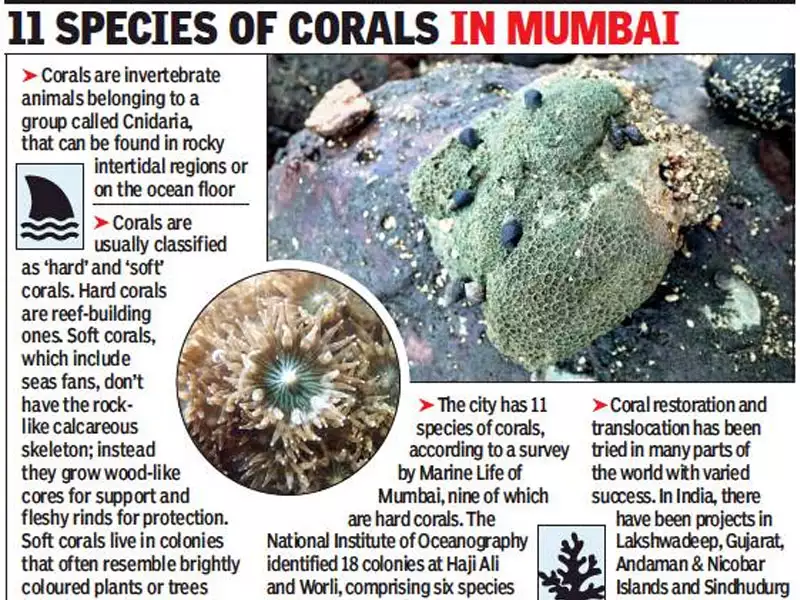Translocation of Corals in Mumbai | 31 Oct 2020
Why in News
The National Institute of Oceanography will carry out the translocation of 18 coral colonies from the coast of Mumbai for the Mumbai Coastal Road Project.
Key Points
- Corals:
- Corals exhibit characteristics of plants, but are marine animals that are related to jellyfish and anemones.
- They are made up of genetically identical organisms called polyps, which are tiny, soft-bodied organisms.
- At their base is a hard, protective limestone skeleton called a calicle, which forms the structure of coral reefs.
- These polyps have microscopic algae called zooxanthellae living within their tissues. The corals and algae have a mutualistic (symbiotic) relationship. i.e.
- The coral provides the zooxanthellae with the compounds necessary for photosynthesis.
- In return, the zooxanthellae supply the coral with organic products of photosynthesis, like carbohydrates, which are utilized by the coral polyps for synthesis of their calcium carbonate skeletons.
- Zooxanthellae are also responsible for the unique and beautiful colors of corals.
- There are 2 types of corals:
- Stony, shallow-water corals—the kind that build reefs.
- Soft corals and deep water corals that live in dark cold waters.
- Coral Reefs:
- Reefs begin when a polyp attaches itself to a rock on the seafloor, then divides, or buds, into thousands of clones. The polyp calicles connect to one another, creating a colony that acts as a single organism.
- As colonies grow over hundreds and thousands of years, they join with other colonies, and become reefs.
- Coral reefs cover less than 1% of the ocean floor but they are among the most productive and diverse ecosystems on Earth. They are referred to as the rainforests of the sea for their biodiversity.
- Benefits: Coral reefs are like underwater cities that support marine life.
- According to the United Nations Environment Programme (UNEP), they provide at least half a billion people around the world with food security and livelihoods.
- Coral reefs also act as ‘wave breaks’ between the sea and the coastline and minimise the impact of sea erosion.
- According to a recent study of University of Queensland (UQ), Australia, more life can be supported by dead coral remains than live corals.
- Protection: In India, they are under Schedule I of the Wildlife Protection Act (WPA), 1972.
- Threats: Climate change remains one of the biggest threats to corals.
- Around the world, this threat has been visible in the “bleaching” of corals.
- Coral Bleaching: It is a process during which corals, under stress from warm weather, expel the algae that give corals their brilliant colours and live in their tissues and produce their food.
- The Great Barrier Reef off the coast of Australia has suffered six mass bleaching events due to warmer than normal ocean temperatures in 1998, 2002, 2006, 2016, 2017, and now 2020.
- The Great Barrier Reef is a UNESCO World Heritage site and home to one of the largest collections of coral reefs on the planet.
- Biorock Technology: It is a method to restore coral reefs using biorock or mineral accretion.
- Under this low voltage electrical currents through seawater is applied, causing dissolved minerals to crystallize on structures, growing into a white limestone (CaCO3) similar to that which naturally makes up coral reefs and tropical white sand beaches.
- Biorock, also known as Seacrete or Seament, refers to the substance formed by electro-accumulation of minerals dissolved in seawater.
- Coral Translocation:
- The translocation of corals is at a nascent stage along the Indian coastline. It is difficult and has not been very successful in India.
- Pilot projects at various sites including, Lakshadweep islands and Andaman islands have been undertaken to study the survival rate, method and site of translocation, and creation of high heat-resistant coral colonies, etc.
- Transplanted corals are more susceptible to storm surges and bleaching from warming ocean waters.
- Experts are of the view that for a high survival rate, it is important to translocate corals in a place with similar environmental characteristics such as depth, current flow, amount of light, and pressure.
- The translocation of corals is at a nascent stage along the Indian coastline. It is difficult and has not been very successful in India.

